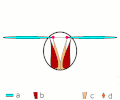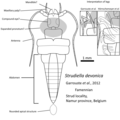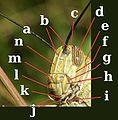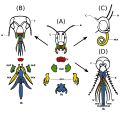Portal:Insects
The Insects Portal


Insects (from Latin insectum) are hexapod invertebrates of the class Insecta. They are the largest group within the arthropod phylum. Insects have a chitinous exoskeleton, a three-part body (head, thorax and abdomen), three pairs of jointed legs, compound eyes, and a pair of antennae. Insects are the most diverse group of animals, with more than a million described species; they represent more than half of all animal species. (Full article...)
Selected article -
Termites are a group of detritophagous eusocial insects which consume a variety of decaying plant material, generally in the form of wood, leaf litter, and soil humus. They are distinguished by their moniliform antennae and the soft-bodied and often unpigmented worker caste for which they have been commonly termed "white ants"; however, they are not ants, to which they are only distantly related. About 2,972 extant species are currently described, 2,105 of which are members of the family Termitidae.
Termites comprise the infraorder Isoptera, or alternatively the epifamily Termitoidae, within the order Blattodea (along with cockroaches). Termites were once classified in a separate order from cockroaches, but recent phylogenetic studies indicate that they evolved from cockroaches, as they are deeply nested within the group, and the sister group to wood eating cockroaches of the genus Cryptocercus. Previous estimates suggested the divergence took place during the Jurassic or Triassic. More recent estimates suggest that they have an origin during the Late Jurassic, with the first fossil records in the Early Cretaceous. (Full article...)
Did you know -
- ... that adult males of the parasitic wasp, Encarsia perplexa, can only develop when a virgin female lays eggs in a fully developed larva of her own species?
- ... that anywhere from 60 million to 1 billion monarch butterflies spend the winter at the Monarch Butterfly Biosphere Reserve in central Mexico?
- ... that the bigheaded ant, Pheidole megacephala, protects the source of its food supply, green scale insects, by removing predatory larvae that might eat them?
- ... that three partial cross veins in the wings make D. appendiculata a unique fruit fly among the more than 1500 species of Drosophila?
- ... that due to its long life cycle, the adult Great Arctic is only seen every other year?
List articles
Related portals
General images -
Selected image -

The rose chafer Cetonia aurata (Coleoptera: Scarabaeidae) is a beetle, 20 mm (¾ in) long, that has metallic green coloration.
WikiProjects

Main WikiProject:
Related projects:
- WikiProject Arthropods
- WikiProject Spiders
- WikiProject Animals
- WikiProject Tree of Life
- WikiProject Biology
Daughter projects:
Tasks
 |
Here are some tasks awaiting attention:
|
Associated Wikimedia
The following Wikimedia Foundation sister projects provide more on this subject:
-
Commons
Free media repository -
Wikibooks
Free textbooks and manuals -
Wikidata
Free knowledge base -
Wikinews
Free-content news -
Wikiquote
Collection of quotations -
Wikisource
Free-content library -
Wikiversity
Free learning tools -
Wiktionary
Dictionary and thesaurus


















































